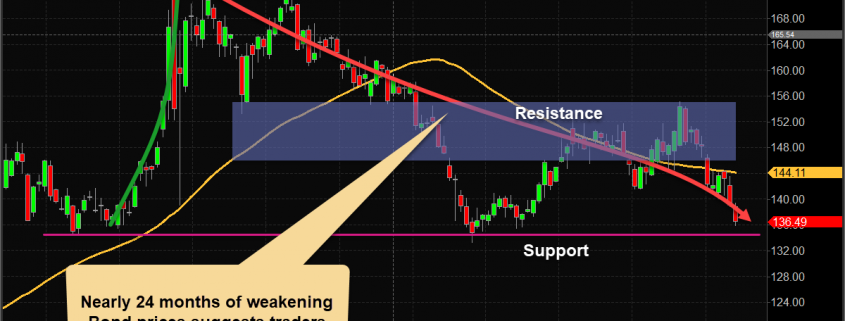Bonds Not Reflecting Risks Like They Usually Do – Where’s The Beef?
I’ve been paying close attention to Bonds as the global markets react to rising inflation and global central bank moves recently. The US Federal Reserve has yet to take any actions to raise rates, but we all know it will come at some point. Longer-term bonds are acting as if these risks are much more subdued than many traders/investors believe – which has me questioning if global central banks have overplayed the stimulus game?
Why would traditional safe-haven assets fail to act in a manner that reflects current market risks like they would typically do? Why have precious metals failed to reflect these risks also properly? Is there something brewing in traders’ minds that are muting or mitigating these traditional safe-haven assets?
Bonds Continue To Slide After COVID Rally
This table, reflecting the recent downward trend in Bonds, highlights the weakened safe-haven tendencies. These assets would generally present with rampant inflation and the possibility of multiple Fed rate increases.

(Source: SeekingAlpha.com)
Increasing uncertainty throughout the globe, and as inflation climbs to the highest levels since the mid-1970s and 1980s, – “where’s the beef?” (to reference a 1980s Wendy’s commercial phrase).
This TLT Weekly chart shows how risks climbed when COVID hit in February 2020. Yet, take a look at how price has consolidated below $156 and has continued to trend lower over the past six months.
After a brief move higher, to levels near the $147 to $155 level, TLT has moved decidedly lower over the past 6+ months. This downward price trend illustrates the diminishing fear levels as traders piled into the post-COVID rally phase. This move suggests traders believe inflation may be temporary or that the US Federal Reserve has room to raise rates without disrupting the global economy. I think the current premise and price trend in TLT vastly underestimates the amount of disruption a series of Fed rate hikes would cause the international markets.

The US Federal Reserve will likely consider all options before taking an aggressive move to raise rates. Additionally, the US Fed may decide to allow foreign central banks to move more aggressively to raise rates while it decides to take a more measured approach to inflation.
The key to future rate increases is how supply chains open up and how consumers continue to engage in economic activities. Any sudden shift by consumers, or further disruptions in supply for manufacturing and consumer staples/discretionary items, could prompt the Fed into taking aggressive actions.
From where the Fed Funds Rates currently are, a move above 0.50% would reflect a +500% rate increase. This may prompt some type of “pop” in certain asset bubbles.

(Source: St. Louis Fed)
Traders should stay keenly focused on market risks and Bond levels throughout 2022 into 2023 as any sudden shift away from current trends could spell trouble. Right now, Bonds are pricing in minimal risks – which may be a mistake.
The market dynamics and trends are changing from what we have experienced over the past 40 years for stocks and bonds. The 60/40 portfolio is costing you money now, and bonds can’t keep up with inflation and are more or less yield-less.
The only way to navigate the financial markets safely, no matter the direction, is through technical analysis. By following assets and money flows, we identify trend changes and move our capital into whatever index, sector, industry, bond, commodity, country, and even currency ETF. By following the money, you become part of new emerging trends and can profit during weak stock or bond conditions.
What Trading Strategies Will Help You To Navigate Current Market Trends?
Learn how I use specific tools to help me understand price cycles, set-ups, and price target levels in various sectors to identify strategic entry and exit points for trades. Over the next 12 to 24+ months, I expect very large price swings in the US stock market and other asset classes across the globe. I believe the markets are starting to transition away from the continued central bank support rally phase. This may start a revaluation phase as global traders attempt to identify the next big trends. Precious Metals will likely start to act as a proper hedge as caution and concern start to drive traders/investors into Metals.
I invite you to learn more about how my three Technical Trading Strategies can help you protect and grow your wealth in any type of market condition by clicking the following link: www.TheTechnicalTraders.com
Chris Vermeulen
Chief Market Strategist
Founder of TheTechnicalTraders.com



